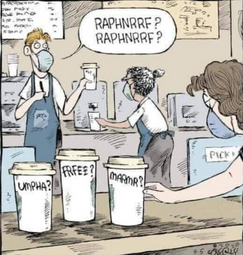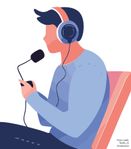-
About
Our Story
back- Our Mission
- Our Leadershio
- Accessibility
- Careers
- Diversity, Equity, Inclusion
- Learning Science
- Sustainability
Our Solutions
back
-
Community
Community
back- Newsroom
- Webinars on Demand
- Digital Community
- The Institute at Macmillan Learning
- English Community
- Psychology Community
- History Community
- Communication Community
- College Success Community
- Economics Community
- Institutional Solutions Community
- Nutrition Community
- Lab Solutions Community
- STEM Community
- Newsroom
Hearing While Deaf
- Subscribe to RSS Feed
- Mark as New
- Mark as Read
- Bookmark
- Subscribe
- Printer Friendly Page
- Report Inappropriate Content
You’ll be told that your hearing’s so murky and muddy,
your case calls for special intensified study.
They'll test you with noises from far and from near
and you'll get a black mark for the ones you can’t hear.
Then they’ll say, “My dear fellow, you’re deafer than most.
But there’s hope, since you’re not quite as deaf as a post.”
~Dr. Seuss in You’re Only Old Once!
Dr. Seuss could be talking to me. Although not part of the signing Deaf culture, I am—without my cochlear implant in one ear and hearing aid in the other—deaf. With the technology removed, I experience the sound of near silence. I cannot hear my wife from the adjacent pillow unless I put my “good” ear 4 inches from her mouth. Not quite as deaf as a post!
My loss, which began as an unusual low frequency loss that made me a case of special intensified study, is the least of my mother’s gifts, which she inherited from her mother. Our shared experience is the result of a single gene defect, which a University of Iowa hearing geneticist identified for me during our years together on the advisory committee of NIH’s National Institute of Deafness and Other Communication Disorders: “You have DFNA6/14 hearing loss caused by a mutation in WFS1.”
Yet I am really not so special, for there are some 38 million American, and 4 million Canadian, adults who experience some “trouble hearing,” or who have at least a 25 decibel loss in both ears. Hearing loss is one of the great invisible disabilities.
In my workplace, I have many times experienced unintended exclusion—mostly unnoticed by others. In department meetings, I have missed much of others’ input. Attending lectures, I have sat trapped in the middle of an audience, missing most of the spoken word. Hearing worsens in auditoriums with distant ceiling speakers and in uncarpeted hard-surfaced rooms with reverberating sound. Facilities designers, take note!
Had I been left out in such settings because of wheelchair inaccessibility, people would be aghast, and would engineer a remedy. Hearing loss, by contrast, is unseen and thus often unremedied. Moreover, Covid-era masking made things worse, both muffling sound and precluding natural lip reading.

Hearing loss does nevertheless have a few compensations. Normal-hearing folks have eyelids but no earlids. I have both. When working in a noisy coffee shop, I can turn down the sound distractions. Has your sleep been disturbed by hotel hallway noise? That’s no problem for people like me. Earlier this week, my wife’s sleep was disturbed by our bedroom’s phone ringing at 1:30 a.m. I was blissfully unaware.
When hearing folks witness those with hearing loss not comprehending speech, they may misattribute the problem. During his Congressional testimony regarding possible Russian election interference, former special counsel Robert Mueller on 48 occasions asked to have questions repeated. Commentators, not appreciating that he is hearing-challenged, observed that he seemed “confused,” “uncertain,” and “forgetful.”
And it was all so easily avoidable in one of three ways—each of which I have experienced as a godsend:
- A loudspeaker nearer his ears could have given him vastly clearer sound.
- Real-time captioning on a table screen, like the TV captioning we use at home, could have made the spoken words instantly clear.
- A hearing loop surrounding the room could have magnetically transmitted the voice from each microphone directly to the inexpensive telecoil sensor that comes with most modern hearing aids and cochlear implants. (See here, here, and here for more on hearing loops, which are now in thousands of auditoriums, worship places, and airports. Full disclosure: The first site is my own informational website, and the last describes our collective advocacy to bring this technology to all of the United States.)
There are other ways to support people with hearing loss:
- Create quieter working and eating places, with materials that absorb reverberant sound.
- When beginning a talk, do not ask “Can everybody hear me?” and then put down the mic. (That question can elicit but one answer.)
- When offered a mic, use it, held close to the mouth:
4. When hosting a group meeting, cluster seating close together (to minimize speaker-to-listener distance).
5. Enable presenters to see their PowerPoint presentation in front of them, such as with a podium laptop--to minimize their turning their back to the audience when talking through their slides.
Those of us with hearing loss can also act to give ourselves ear-opening experiences:
- We can be “out of the closet”: “I have hearing loss, so it would help me if we could be seated in a quiet corner [or] if we could turn the music down.”
- When attending talks, we can sit front and center.
- We can equip our ears with today’s “superfecta” digital hearing aids, offering both a Bluetooth link from smartphone to hearing aids and a telecoil for hearing loop reception. (Studies indicate that those with hearing loss who resist hearing aids—often because they are unaware of what they’re missing—are at increased risk for social isolation, depression, and eventual dementia.)
- We can harness other hearing technologies. For example, I love my hand-held directional remote mic, such as available here. When pointed at someone in a meeting or at a noisy reception, it zooms in on their voice. When connected to my laptop, my hearing aids become in-the-ear speakers.
Hear ye! Hear ye! The happy news is that today’s technologies enable people like me to escape the deafness that caused Beethoven to lament living “like an exile” and to experience social encounters with “a hot terror.” I am also spared the isolation that plagued my deaf mother’s later years. No longer must our hearing be “so murky and muddy.”
Hearing is not the only vehicle for communication. ASL is also a genuine language. But for those of us who have experienced hearing, how good it is. For we are, as Aristotle discerned, “the social animal.” We need to belong. We live in relationships with others—a feature of our human nature immediately recognized in the Old Testament creation story (“It is not good that the man should be alone”).
As people who need people, we can therefore celebrate the wonder of hearing—of mind-to-mind communication via vibrating air molecules.
(For David Myers’ other essays on psychological science and everyday life, visit TalkPsych.com or his new essay collection, How Do We Know Ourselves: Curiosities and Marvels of the Human Mind. Follow him on Twitter: @davidgmyers.)
-
Abnormal Psychology
6 -
Achievement
2 -
Affiliation
1 -
Behavior Genetics
1 -
Cognition
7 -
Consciousness
8 -
Current Events
29 -
Development Psychology
14 -
Developmental Psychology
9 -
Drugs
1 -
Emotion
13 -
Gender
1 -
Gender and Sexuality
1 -
Genetics
3 -
History and System of Psychology
3 -
Industrial and Organizational Psychology
2 -
Intelligence
4 -
Learning
3 -
Memory
2 -
Motivation
3 -
Motivation: Hunger
2 -
Nature-Nurture
4 -
Neuroscience
6 -
Personality
10 -
Psychological Disorders and Their Treatment
10 -
Research Methods and Statistics
22 -
Sensation and Perception
10 -
Social Psychology
87 -
Stress and Health
8 -
Teaching and Learning Best Practices
7 -
Thinking and Language
14 -
Virtual Learning
2
- « Previous
- Next »


